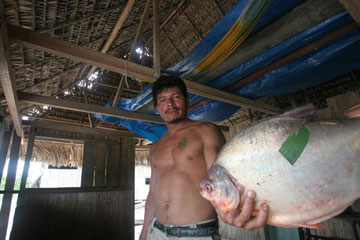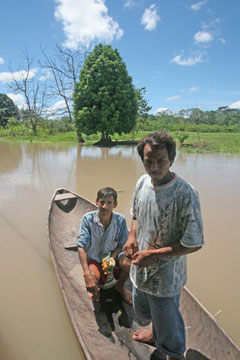Special to mongabay.com: Wilderness Classroom: Expedition 2006 The following is an update from The Wilderness Classroom’s expedition to the Peruvian rainforest. You can follow their adventures at wildernessclassroom.com |
Fish Flow with the Floods in the Amazon
The Wilderness Classroom Organization
April 12, 2006
Update 8: Fish Flow with the Floods – Patrick
Today we came across a man that had made a very lucky catch. A bunch of Tambaqui (tam-bah-KEE), were in the bottom of his canoe ready to be cleaned and prepared for eating. Finding these fish in the vast flooded forest takes a lot of knowledge and experience.
The entire life of the Tambaqui, also called a Pacu, follows the annual rise and fall of the floodwaters. The young are born in the river channel and are carried by the high water into the floodplain, where they live in the floating meadows and eat grass seeds. The fish use their keen senses of smell and vision to find their favorite fruits and seeds in the forest. Tambaqui are unique in their love for rubber tree seeds. They crush the hard seed coating with large molar-like teeth and swallow the seed whole. This does not destroy the seed, in fact, the process is a necessary step in germination, or preparing the seed to sprout. Later, the seed will grow into a rubber tree.
Tambaqui feast throughout the flooded forest, then move with the receding waters back to the river channel. The high consumption of fruits and vegetables during the floods allow the Tambaqui to store 10 percent of its body weight as fat. The fish live off their fat in the low-water season when food becomes harder to find.
The fresh fish the man caught will provide this family with lots of protein-rich meat. Floods are a difficult time to catch fish, which provide useful proteins and fat. We might have too much fatty food in the USA, but in Peru most of the riberenos’ diet consists of starch, and carbohydrates. Knowing where and when the rubber tree’s seed capsule mature and explode is good way to find Tambaqui fish. I only wish is was that easy. Some fish would be a nice addition to our diets too. Where do you get protein and fat in your diet?
Update 8: Boat maker, boat maker, make me a boat – Anna
In the flooded forest, canoes are made by hollowing out rainforest trees. A man named Manceo built one of our canoes, from a catawa tree in ten days. He had owned the finished canoe for only one month before selling it to us for 200 soles, or 60 dollars.
 This Tambaqui will add much-needed protein and fat to a riberenos’ diet. Tambaqui are actually closely related to the piranaha. One main difference is that Tambaquis have blunt teeth to feed off of seeds, plants, and plankton. A Tambaqui may grow up to 3 feet in length and weigh 65 pounds. |
Manceo is 52, and has been building canoes out of all types of wood for 18 years. He says catawa is his favorite type of tree because it makes very light and buoyant canoes.
Manceo says that he has made too many canoes to count in the past 18 years. The longest that he made was about 35 feet long, and was used as a motor boat. That particular canoe took two men about one month to build.
Manceo says that in the dry season, or the summer, it is much easier for him and his family to survive in the rainforest. In the dry season, the good canoe-quality trees are easier to find, and they are not water logged like in the rainy season. When the wood is easier to find, Manceo can make more canoes and therefore bring home more money to his family.
 Manceo (seated), and his brother, make a living by making dugout canoes out of rainforest trees. The brothers use three things to make a dugout canoe: a machete, an axe, and a jug of water. On average, it takes about ten days to make one canoe that sells for about sixty dollars. |
Manceo says that this year’s flooding is average for April. He says that the most he has ever seen the river flood is about two yards higher than it is right now, which means that the main floor of the house where we have been staying would be under water. That was in the 1970s.
In the flooded forest, work opportunities change with the changing seasons. In the United States, many people work indoors; therefore, their work is not affected by the seasons. However, there are still many outdoor jobs in the United States that are affected by the weather. Think about the jobs that your family members have where you live. Do the changing seasons affect their work? How?
Update 8: What Time is Dinner? – Anna
When things are getting tough in the rainforest, we always know that we can count on a nice, stove-cooked meal when we get to camp each night…..or can we?
As we canoe through the flooded forest, we might not see dry land for several days at a time. This situation might make cooking our dinners quite interesting and a bit difficult. Where and how do we cook? Another issue that might add to the complications of cooking at night are our flying friends, the mosquitoes. When the sun goes down, the mosquitoes come out in full force. Swarms of mosquitoes buzzing around our heads can be rather uncomfortable when we are trying to cook. I think I’d rather be in the safety of my mosquito netted hammock!
Most of the food we have brought along on our journey is dry; it has to be cooked in order to eat. This is because we do not have a way to preserve fresh food in the heat of the rainforest.
So no matter what, we have to cook our food. The question is how do we eat when there is no dry land and swarms of mosquitoes eating us for dinner?
We would love to hear any suggestions you might have as to how to get through this dilemma.
Track the adventurers at wildernessclassroom.com